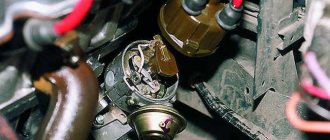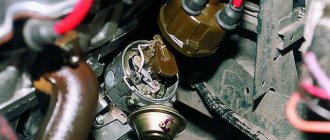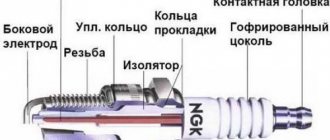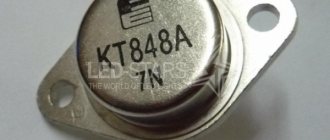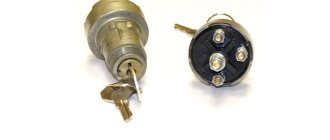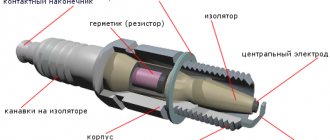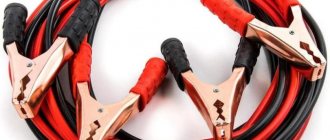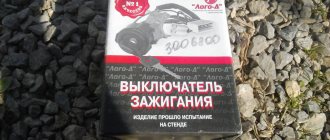High-voltage wires used in automotive ignition systems are gradually being forced out of the market. The fact is that automakers are actively promoting ignition technology without the use of wires, in which the ignition coil is placed directly on the spark plug. Nevertheless, such conductors have shown themselves to perform well: they are extremely resistant to external influences, durable, and easy to manufacture. A significant number of cars on the roads are equipped with just such wires. Let's figure out how to use them and choose the right ones.
Place of wires in automotive ignition systems
Today, a high-voltage wire is used in conjunction with a distributor or an electronic control unit. The first option is often called simply mechanical, and the second - a static power distribution system. Here's how it works:
- Distributor system . Using the ignition coil, the energy from the 12-volt battery is converted into several thousand volts, which are distributed using a mechanical distributor. There is always one wire from the coil to the distributor and the number of wires that corresponds to the number of spark plugs;
- System with ECU . The modified system is equipped with candles, each of which has a coil. The number of wires is dictated by how many coils will be supplied with voltage from the control unit. We only note that the coil can provide operation of one spark plug or two at once, as is the case in dual-spark DIS systems.
Only one fact remains unchanged: the high-voltage wire must supply voltage from the coil to the spark plug. In accordance with this, wires with specified characteristics are selected. Let's try to explain.
Products from Carden: main features
Products from this brand are used on cars of various brands: GAZ, ZAZ, VAZ and so on. The products are designed to operate at temperatures up to +180 degrees. The minimum indicator is minus forty degrees. The length of the wires may exceed the length of those products installed on the vehicle.
Carden high voltage wires
The characteristics of products from this company are high, since they contain two layers of silicone insulation. The company guarantees that the wires will withstand considerable voltage - up to 45,000 volts. Before installing new products, it is necessary to check the spread of their resistance. If it is too high, then you should think about replacing the old options.
Conductor Specifications
When making a wire, most attention is paid to the core and insulation. The core can be copper, a special graphite thread, a thread made of flax or fiberglass. Non-metal conductors perform well, since they do not require additional resistors.
Insulation is almost always multi-layered. The outer protective layer makes the entire wire resistant to mechanical and chemical influences, the middle of the wire is made of dielectric, and the braiding of the conductor is deliberately made quite rigid. As a result, we get an extremely durable and not too flexible wire. It is not afraid of temperature, exposure to automotive chemicals, dust and moisture. According to the standard , the insulation must cope with a voltage of 40,000 V.
Design features
Timely ignition of the fuel mixture depends on the serviceability of high-voltage spark plug cables, which are structurally composed of protective caps, a tip (made of metal), as well as a conductor and insulating material.
Insulation prevents leakage of electric current, protects products from the harmful effects of humidity, various lubricants, gas vapors, and high temperatures. It is an insulating coating that does not conduct electricity; it covers the core that conducts current.
The lugs serve as a connection for the conductor conductor and contacts. They must meet the requirements:
- strong fastening on the wire;
- connecting the SZ leads to the coil or distributor cap;
- good resistance to corrosion, helping to preserve contacts during long-term use;
- integral connection with a material that conducts current.
The purpose of the caps is to protect the places where the contacts are attached to the terminals of the SZ, coil or distributor from the aggressive influence of the external environment, as well as electric current leakage. Caps must meet the following parameters:
- sealed connection with elements of the ignition system to prevent the penetration of dust and moisture;
- stability of initial characteristics at low and high temperatures.
Conventionally, explosive wires are divided in this way:
- Classic products have a copper core. Their advantage: low electrical resistance, long service life. Such products increase the power of the spark. Disadvantages: rigid insulation, which hardens after a long period of use or in the cold.
- Products with a resistive core. Their advantage lies in their ability to withstand high tensile loads. Plus, a silicone coating is used, which is resistant to temperature changes and does not tan in the cold. Disadvantages: lower spark power compared to the classic version.
More about zero resistance wires
On older cars you can often find high-voltage copper wires with zero resistance. They have a number of disadvantages:
- Electromagnetic interference . We have already talked about the fact that modern spark plugs can require up to 35,000 V. When the system operates, the so-called skin effect and energy distribution in the space around the conductor are observed. Of course, the energy losses are not too great, but they are enough for the same radio to start working with interference. The problem is partially solved by installing additional resistors to suppress interference;
- Impact on insulation . Unfortunately, the insulation quality of a zero-resistance wire deteriorates too much as it is used. You cannot turn a blind eye to this for a number of reasons, one of which is the deterioration of the spark plug. The result: dirty exhaust, loss of power due to incomplete combustion of the fuel mixture.
However, these shortcomings do not always manifest themselves fully. Simply, wires with nylon or cotton threads impregnated with soot, replacing the “zero” ones, turn out to be noticeably better. The most modern wires have glass fiber inside, on which graphite is sprayed.
ZAZ 968 M Compressor › Logbook › Selecting high-voltage wires: do not believe, but check!
In one of the issues of the magazine "Behind the Wheel" a review of high-voltage wires (HVP) for carburetor "Samar" was carried out. Now I propose to consider the choice of high-voltage wires (HVP) for injection engines in order to know one of the possible reasons why the engine “troubles”, and in winter or in the rain it is difficult or does not start at all. I encountered one of these problems at the beginning of autumn. Why do I need GDP for the injection Samara? Let this remain a little secret for now. As you know, there is GOST 14867-79, which defines the basic requirements for GDP. Brief excerpts from it: High voltage wires TU 16-705.273-83. Purpose: use in shielded car ignition systems Brand: PPOV (P - wire; P - polyethylene insulation; O - irradiated; B - polyvinyl chloride sheath). Operating conditions: -climatic version O according to GOST 15150-69. — operating temperature from minus 60 to 110°C. — the wire is resistant to oil, gasoline, ozone, mold, and does not propagate combustion. Safety requirements: according to GOST 12.2.007.0-73. Technical characteristics: - maximum voltage of ignition pulses transmitted by the wire, kV - 22 - breakdown voltage of the wire, kV, no less than - 40 - electrical capacitance of the wire, pF/m, no more - 100 - service life - 8 years - warranty period is set at 5 years from the date of putting the wire into operation with operating hours not exceeding 2000 engine hours or 40 thousand km of vehicle mileage Design and principle of operation The conductor is made of copper wires and corresponds to class 4 according to GOST 22483-77, insulated with radiation-modified polyethylene grade 153 -118 according to TU 6-05-05-77. A sheath of polyvinyl chloride plastic compound, grade IT-105, in accordance with GOST 5960-72, is placed on top of the insulation. Nominal cross-section of the conductor, mm2 – 1.0 Number and diameter of wires, mm – 19×0.26 Nominal diameter of the conductor, mm – 1.3 Minimum radial thickness, mm: insulation – 2.0, sheath – 0.55 Maximum outer wire diameter, mm – 7.3. However, since 1979, due to changes in the circuitry and design of ignition systems, their operating conditions and the requirements for them have changed greatly. This is due primarily to the introduction of Euro 2, 3, 4 standards and the transition to microprocessor-based non-contact ignition systems, which required an increase in spark power, and secondly, to stricter requirements for electromagnetic compatibility (EMC) due to an increase in the number of electronic systems vehicle and ensure their reliable operation. Let's approach the selection of one of the most important components of a car's ignition system from a practical point of view. We will define the following as the main parameters: the active component of the resistance, the breakdown voltage, the level of the created electromagnetic field and, of course, the price. The education of a software engineer received at a university and work related to the development of information security systems made it possible to select the necessary set of equipment to evaluate each of these parameters from a practical point of view. So, the composition of laboratory equipment: - MY68 multimeter
Advantages and disadvantages of each type
Now let's try to summarize the information about each type of wire:
- Copper . They may have additional internal resistance, or they may be created without it. If their internal resistance is zero, i.e. Inside there is a regular core made of copper wire, the installation of additional resistances is required;
- With distributed resistance . Consist of several layers. They themselves are difficult to manufacture, but they have improved insulation (there is a complex inner and outer layer) and core. In European wires, the distributed resistance is 9-25 kOhm/m. As a result, radio and television interference is not created at all. We installed the wire and off we went;
- With inductive reactance . A very interesting solution. A so-called pulsating magnetic field appears in the wire. The ignition coil accumulates energy during operation and then releases it. As a result, the inductive voltage in the cable can increase. In such wires, the resistance is a variable value, which depends on the frequency at which the motor operates. The most modern solution, but, alas, expensive.
The simplest copper wires are still used only because their production, as well as additional noise suppression resistors, does not require large financial expenditures. For this reason, workshops can easily make you a high-voltage wire using terminals and a coil of ordinary Chinese wire with a blue silicone sheath.
SELECTION OF THE BEST GDP FOR VAZ 2114
When choosing high-voltage wires, preference should be given to trusted manufacturers, among which are Cargen, Finwhale, Tesla, and Slon. They cost an order of magnitude more than Chinese wires, but there are fewer problems with them - set and forget, while the Chinese are not particularly reliable and durable.
It is worth noting that there is no single standard for technical characteristics for all GDPs - products from different manufacturers have different resistances.
Table indicating the resistance of explosive wires
The test of the most popular GDPs showed the following indicators of breakdown voltage: The lower the resistance of high-voltage wires, the better. However, when choosing, it is necessary to take into account the breakdown voltage, the indicator of which should be as high as possible.
- Slon: <50 kV;
- Ween: <35 kV;
- Cezar: <50 kV;
- Tesla: >50 kV;
- Finwhale: > 50 kV.
As evidenced by reviews from car owners, the best option for GDP for injection engines, including the fourteenth, is Tesla wires.
More information about high-voltage wire terminals
The terminal is needed for high-quality and durable contact. Since the junction of the wire with the energy-consuming device can be called weak, it is covered with a special cap. As a result, the system will work reliably even in hostile environments. Automotive terminals are usually protected with silicone caps. This material is not afraid of water, dust, or auto chemicals.
There are the following connectors for automotive spark plugs : SCREW/VRUT, M4, SAE, DIN, D4. As a rule, in modern cars the terminals are removable, so there is a SAE connector for a latch and an M4 for a thread.
It breaks where it breaks
In order not to miss when choosing high-voltage wires, it is worth considering several recommendations.
Firstly, you should pay attention to the information indicated both on the packaging and on the wires themselves: manufacturer, applicability, etc. Very often, “leftist” manufacturers make mistakes in spelling the word “silicone” in English. The correct option is “silicone”. This is such a common mistake that even one of the most famous Russian auto publications indicated “silicon” in a large article, which means “silicon” in Russian.
Secondly, pay attention to the wire caps. They must ensure a tight connection and protect the contact tips. High-quality caps are made from rubber based on silicone rubber. The wall thickness must be at least 3 mm. It is at the junction of the contact with the current-carrying conductor and other parts of the ignition system that most often the electrical network is disrupted. This usually happens either when the wires are removed (they often pull directly on the wires) or there is a poor connection to the terminals of the corresponding elements of the ignition system due to oxidation, loose fit, etc.
Thirdly, you should pay attention to the quality of the high-voltage cable itself. The best ones are made of silicone; you can check their reliability in simple ways. Place the cable in an open flame - high-quality insulation should not easily melt or ignite. Twist the cable tightly. Signs of displacement, sliding between the sheath and the conductor, as well as crunching indicate poor quality of the mechanical adhesion between the sheath and the insulator. Also try to move the insulating layer longitudinally. The cable must be practically monolithic, otherwise protection may be violated during installation and removal of the wire.
Finding out when to replace wires
Please note that there are no regulations for replacing explosive wires. You need to navigate along the way. There is a lot to consider:
- The engine began to “trouble” and run rough, and fuel consumption increased. Most likely the wire has broken. The engine freezes at high speeds, since the electromagnetic pulse in the ignition system has decreased and the spark is either weak or absent at all;
- The wire began to spark and glow. You can observe this phenomenon if you look under the hood of a running car. The problem is insulation or contacts. This wire is only for replacement;
- Inspection revealed the presence of external damage. The easiest way is to simply replace the wire with a new one.
As a rule, high-voltage wires fail without any intervention, although sometimes they are “killed” by a technician who carelessly removes the spark plug. You can accurately determine their malfunction by observing the engine at idle speed, as well as using a tester. If it shows an open circuit (resistance is infinity), the wire will need to be changed.
We also note that unknowing people confuse wiring faults with those of a spark plug. Yes, the high voltage wire determines the operation of the spark plug. However, without “experiment” it will not be possible to determine the broken part. Since checking spark plugs is a very troublesome task, it is more advisable to remove the wire and check it with a multimeter, setting the measurement limit to 20,000 Ohms.
Testing high-voltage ignition wires behind the wheel
Here is an article from the experts at “Behind the Wheel”
EXAMINATION: high-voltage wires. The Path of Thunder Authors: Mikhail Kolodochkin, Alexander Shabanov Most smart textbooks avoid this topic. Like, the ignition system is mainly spark plugs and coils. True, there are still some high-voltage wires between them. But there seems to be nothing to say about them: wire is just wire in Africa.
Are they all the same, and also problem-free? To figure this out, we purchased sixteen sets of wires for carburetor Samaras in Moscow stores.
Looking ahead, we note that this examination surpassed even spark plugs in terms of complexity and volume of work!
The motor is there, “Behind the glass”...
The average consumer's requirements for high-voltage wires are simple - let them conduct current properly and not fall off on their own. The ideal would be a thick copper wire with zero resistance - that’s all science...
The specialist will nod respectfully: they say, everything is correct, but... The resistance of the wires should not be zero - otherwise the level of interference from the ignition systems will become such that even flying saucers will stall. Yes, the discharge will become weaker, but you have to put up with it. We must also not forget that the wires must be “all-weather” - complaints about Russian frost and engine compartment heat are not considered. And, of course, the parameters of wires from one set should be as close as possible - this is understandable.
The examination of the wires was divided into two parts - non-motorized and motorized. After a visual inspection, we assessed the length of the wires and their resistance, then determined the force of tearing the wire off the spark plug, and then sent everyone to the refrigerator. As for motor tests, with each kit installed on the engine, measurements of power, fuel consumption and exhaust gas toxicity were carried out. And the final quality indicator was determined using a point system. During each test, the result of the best set was equal to 5 points, and the worst - to zero, the rest were located in between.
PERCENTAGES, JOULES AND LEAKS
The influence of wires on the life of the engine is reflected, naturally, through the energy of the discharge - there is simply nowhere else. But how much of this discharge reaches the spark plug electrodes? First, the gaps in the contacts of the ignition distributor cap interfere, then leaks through the wire insulation will steal something. Have you seen how flashes of electrical discharges rush around the wires in the dark in humid weather? These are the same leaks that steal joules from the candles. Then again there is a gap in the contact between the wire and the spark plug tip. And the worse the wire, the greater these losses.
What does this mean? Firstly, the combustion rate decreases, hence the gluttony, dullness of the engine, and “tasteless” toxic exhaust. Secondly, the moment of combustion begins shifts towards late ignition. After all, in order for the discharge to pass through the gap of the spark plug, it takes some more time - under the influence of high voltage, the initially non-conducting air with fuel vapor must be ionized. And the lower the voltage on the electrodes, the more the ignition delay increases. We may be talking about milliseconds, but at high revs they translate into actual degrees of crankshaft angle.
And one moment. Almost all of our “under investigation” wires have distributed resistance. Moreover, depending on the length, the resistance of the ignition lines of the first and, say, fourth cylinders could differ by almost two times!
How big is the influence of wires on the operation of the motor - is it about “catching fleas” or about a real difference in percentages, grams and watts? This is exactly what we want to find out.
The length of the central wires for all sets is almost the same. But the rest are quite different: for example, the shortest are those of the VAZ and JanMor. Their owners may have problems putting the wires on, and they may “break.” The longest wires are with the HORS kit (especially the first and second cylinders). In addition to ease of installation, this ensures a certain equalization of resistance along the ignition lines of all spark plugs.
The SenTech kit has the lowest distributed resistance (it does not exceed 0.5 kOhm). For B-Tech it is over 10 kOhm. The best indicators for uniformity of linear resistance are found in the SenTech, Champion and Tesla kits (range 3–4%), the worst are in Wego, Ween, JanMor and Master Sport (20–33%).
You can fit onto a candle in different ways... A normal cap fits tightly, but the “Master Sport” cap fits only halfway.
Remember the jokes about machine guns with a crooked barrel? Which option seems better to you?
When assessing the force of tearing the wire from the spark plug, the “work” of both the tip and the cap, worn to the maximum possible level, was assessed. Naturally, the winners were products with spring-loaded tips - Champion, NGK, Tesla, HORS. As for the obvious outsiders, spark plugs fall out of VAZ tips even under the influence of their own weight! Pliers in hand and off you go?
When cooling, the VAZ set completely lost its functionality, the tips and wires lost their elasticity, their installation and dismantling became almost impossible.
The only successful “number” of these wires emerged during motor tests. However, resistor spark plugs, tests at a reduced supply voltage, and then a test to stop sparking again threw them to the bottom of the table - large losses in the contacts of the tips affected them. The best were Champion, NGK, SenTech and HORS.
In terms of electromagnetic radiation, NGK, Caesar and SenTech were ahead. To be fair, we note that the absolute leader of Champion’s expertise in this category, to put it mildly, did not shine.
In terms of increasing power, improving efficiency and reducing toxicity, the worst and best wire sets found a difference in power and fuel consumption of up to about 3-5%, and in toxicity - up to 8-10%! Which, in fact, was what needed to be proven... For the curious, we present in the table data on the quantitative change in engine power and efficiency when replacing one set of wires with another. At the same time, all sets of wires, in general, are functional: the main differences will appear in difficult conditions - in winter, in rainy weather, when the battery is dead, etc.
Change in engine power and efficiency depending on the type of high-voltage wires
SO WHERE IS THE ANSWER?
So what wires do we recommend to our readers? If you love your car at least a little above average, then it’s better to choose from at least the first dozen wires. If money does not have a decisive vote, then take “Champion”, if you want to “support your own” - pay attention to HORSE. If you want to save money, be content with the Belgian Ween, but do not approach it with “champion” standards.
Have you chosen? Then – good luck to you and your ignition system along the “Path of Thunder”...
WITH OR WITHOUT RESISTORS?
During the tests, two types of spark plugs were used - with and without resistors. Let us note at the same time: NOT ONE wire manufacturer indicates which spark plugs it considers preferable - with or without resistors. In the same way, candle makers are silent about which additional resistances in the wire circuit they prefer. It seems that the manufacturers of these critical components had a fight in the sandbox in childhood and have not spoken to each other since then. This applies even to those companies that simultaneously produce both! Taking this into account, motor tests were carried out with two variants of spark plugs - A17DVM and A17DVRM: for all occasions. The exceptions were measurements of magnetic and electric fields - here resistorless spark plugs were used, as well as tests at reduced power - here, on the contrary, plugs with resistances were involved. The reasons are clear - in both cases, obviously worse operating conditions were simulated. To eliminate the random factor, resistor spark plugs were chosen with passion - the resistance of each of them is 3.1 kOhm.
Correct installation
If the explosive wires are installed correctly, they do not require further intervention in their operation. Of course, it makes sense to check the cleanliness of the engine compartment. Here's what you need to watch out for during installation:
- The quality of contact fastening must be high;
- Protective silicone caps must cover the terminals;
- There should be no tension or sagging of the wires.
We still advise you to maintain the “salable appearance” of the wires. Clean them from dust and automotive chemicals using a damp cloth and detergents. You should not use force if, when trying to replace the wire, the terminal gets hot and does not come off.
Understanding the choice
You probably already guessed that the high-voltage wire kit includes the conductor itself of a certain length and equipped with a certain terminal with additional protection. So you will have to choose based either on the VIN code of the vehicle, or on the instructions for the car, or on its technical parameters. The new wires should be the same length and connector type as the old ones.
In order not to increase the wear of old wires, it is worth changing everything at once. This will reduce the risk of one of the spark plugs failing. If you have a new car, you will have to use the most expensive and modern wires. The fact is that spark plugs in new vehicle models consume up to 35,000 V, which means they have high requirements for the quality of conductor insulation. Typically, under the hood of foreign cars there are wires with distributed resistance with silicone insulation.
Original high-voltage wires or replacement?
Generally speaking, original spare parts are the ideal way to replace worn parts. But when it comes to high-voltage spark plug wires, many offers are no worse, and even save a little money. In fact, some of the kits listed above are original parts, but without the original automaker logo.
In the end, we can find out which company supplies the high-voltage wires on the assembly line for our car, and buy the same set at a lower price compared to buying directly from an authorized dealer.
Before purchasing a non-original set of wires, it is advisable to make sure that it exactly matches our engine in terms of the diameter of the caps. However, on most packages the manufacturer tries to indicate the most popular models for which the set is suitable. And before installation, you should make sure that the length of the new wire is at least as long as the one being replaced.
Share with your friends!
- Click to share on Twitter (Opens in new window)
- Click here to share content on Facebook. (Opens in a new window)
- More
- Click to share on LinkedIn (Opens in new window)
- Click to share on Pinterest (Opens in new window)
- Click to share on Telegram (Opens in new window)
- Click to share on Skype (Opens in new window)
- Send this to a friend (Opens in new window)
Practical recommendations
In order to buy the best wiring, you should not forget about some things. In the selection process, you should always focus not even on the recommendations of the car manufacturer, but on the recommendations of the engine manufacturer. It would also be appropriate:
- Study the packaging. It contains very important information: manufacturer data, engine and car models. Also, a separate sticker indicates the product’s compliance with the ISO 3808 , if it is a wire from a foreign factory, or GOST 28827-90 , if from a domestic one. Specified operating temperature range: -40°C to 200°C;
- Check to see if it's a fake. Making a fake wire is not very profitable, but the same cannot be said about caps and terminals. If both are of disgusting quality, the transmission of the discharge can deteriorate by one and a half times. Although only a specialist can tell you in detail about some elements of the wire, in order not to buy a fake, you should get a general impression of the product: the terminals should not be skewed, have traces of rust, and the caps should not seem “oaky” to the touch;
- Check insulation. Long-term storage and low suitability of the product are indicated by cracks appearing on it and uneven color of the insulation.
If you decide to switch to a different type of wire, you will have to measure the resistance parameter . There is another, more crude and extremely inaccurate method: if after replacing the wires the car radio began to work with interference, you selected a product with a small additional resistance.
Recommendations for beginners
Before purchasing spark plug wires, pay attention to the connection of the specified products to the coil, especially if it is four-terminal. To simplify the selection of products, you should remove the reel from the car and take it with you to the store. This will allow you, when purchasing a product you are interested in, to check whether the tips fit tightly onto the contact terminal of the coil.
When selecting a kit for contactless electronic ignition of a modern car, it is worth taking a tester to the store. With its help, you can check the explosive resistance on new products; it should be within 8-9 kOhm, and on used ones up to 15 kOhm. In this case, the difference in resistance measurements in one set should not exceed 2-4 kOhm.
For used cars with contact ignition, it is preferable to use classic type kits with a metal core with a resistance of 2 kOhm.
Before purchasing a set of explosive products that interest you, inspect the packaging; it is better that the car model for which they are purchased is written on it in Russian.
Brand tour
We recommend using the VIN code of your car to choose original OEM wires that meet all the parameters.
As for alternative spare parts, things are going well with him. Those manufacturers that supply quality spark plugs also supply excellent high voltage wire. We can note Magneti Marelli from Italy, as well as the German company Beru and the French Valeo.
The most popular among motorists are the German Bosch, the Czech Tesla and the well-known Japanese NGK. From budget solutions, we choose products from the Danish company JP Group and the Czech company Profit.
High-voltage wires for VAZ (Lada) 2113/2114/2115
for repair of VAZ (Lada) 2113/2114/2115
After the replacement the car started to drive a little better.
SLON are worth it, overall I like it for its quality, they also have a lot of gel, i.e. The connectors should be well insulated from moisture (if you unfasten them, an even layer will remain on the spark plugs). I didn't measure resistance. The pro recommended SLON, SLON and took it. So far I'm happy.
There were master sport explosive wires. At night, the color music under the hood is cleaner than with standard red ones.
Horse is complete trash. Slon, Tesla has never had any problems. Bautler (there was a jamb once), but the wires are good.
I recommend ordering Bautler 9 mm wire and DensoTT spark plugs (at a minimum). This combination will pleasantly surprise you and make your car happy.
I went to the store to get new wires, the choice fell on silicone ones, they seemed to be of very good quality and reinforced, they were installed more than once, there were no problems, and I had to get new spark plugs since the spark plug was dying because of the wire, I changed everything, it started to whisper at low speeds and stopped )).
Wires from Slon. The engine runs smoother with them...
Write your review about high-voltage wires
Help others - tell us about your experience using the spare part.
- loading.
- loading.
- loading.
- loading.
- Vectra
- Mokka
- Antara
- Astra
- SPORTS TOURER
- Meriva
- Zafira Tourer
Voted FOR WEEN spark plugs on the rating page
AMD stabilizer stands have only 9 reviews. Perhaps you will add another one?
The Pramo generator only has 60 votes! Do you recommend?
Voted FOR Hola spark plugs on the rating page
DoneDeal cleaners have their first review!
Thule snow chains only have 6 reviews. Perhaps you will add another one?
URW CV joints have only 10 reviews. Perhaps you will add another one?
Eurol motor oil has only 25 votes! Do you recommend?
LUX roof rails already have 100 votes!
There have already been 25 reviews written for Denso cabin filters.
25 reviews have already been written on SAKURA cabin filters.
December 17, 2022, 11:43 pm
There are already 10 manufacturers participating in the auto rating of jacks for VAZ (Lada) Vesta!
December 17, 2022, 11:42 pm
Voted FOR Denso spark plugs on the rating page
December 17, 2022, 10:30 p.m.
There are already 75 manufacturers participating in the auto rating of brake pads for Daewoo Nexia!
17 December 2022, 20:29
McGard secrets already have 100 votes!
17 December 2022, 20:08
There are already 25 reviews written on LUZAR.
17 December 2022, 18:22
So they assembled a homeless kit for you, so nothing worked, you found a crooked installer somewhere, and you have complaints against him. .
17 December 2022, 18:18
These are different brands. You took Meyle, and this is Miles =)).
17 December 2022, 18:17
There are already 5 manufacturers participating in the auto rating of motor oils for Nissan Qashqai!
17 December 2022, 16:10
I replaced the crankshaft position sensor in January 2022. I chose DELPHI. The sensor did not come off for even a year. .
17 December 2022, 15:13
Installed HOLA racks 8 months ago. The struts are excellent, the feeling of a new car is back. I installed gas-oil series G-Ride.
17 December 2022, 15:01
There are already 40 manufacturers participating in the ranking of the best thresholds!
17 December 2022, 14:17
I took a regular filter with white paper, I don’t believe in all these coals and multi-layered nonsense. Fits in frame, blows normally, price tag.
December 16, 2022, 10:08 pm
16 December 2022, 06:43
There are only 10 manufacturers in the ranking of the best blockers. Perhaps you know of someone else?
16 December 2022, 05:05
There are already 60 manufacturers participating in the ranking of the best automatic transmission oils!
15 December 2022, 20:21
There are already 30 manufacturers participating in the ranking of the best car antennas!
14 December 2022, 20:36
There are only 12 manufacturers in the ranking of the best liquid glass. Perhaps you know of someone else?
13 December 2022, 14:55
Voted FOR Hola shock absorbers for Kia Rio on the auto rating page.
12 December 2022, 14:30
Voted AGAINST GSP wheel bearings for Opel Astra on the auto rating page.
12 December 2022, 04:04
There are only 10 manufacturers in the ranking of the best gas equipment. Perhaps you know of someone else?
6 December 2022, 09:26
Voted AGAINST OBK suspension springs for Honda CR-V on the auto rating page.
- Brake pads
- Engine oil
- Tires
- Shock absorbers
- Brake discs
- Spark plug
- Wiper blades
- Battery
- Set of tools
- Cleaners
- Spherical bearing
- DVR
- CV joint
- Antifreeze
- Clutch kit
- Polishes
- water pump
- Radio tape recorder
- Suspension springs
- Shock absorber struts
- Radar detector
- Oil filter
- Steering tips
- Lever arm
- Manual transmission oil
- Fuel pump
- High voltage wires
- Heater radiator
- Thermostat
- Timing belt
- Air filter
- Sealants
- Shock absorber support
- Timing belt tensioner roller
- Washer fluid
- Pistons
- Flushing the oil system
- Brake cylinder
- Auto blanket
- Window lifters
TOP manufacturers of high-voltage wires for VAZ (Lada) 2113/2114/2115
This spare part for VAZ (Lada) 2113/2114/2115 cars is made in different parts of the world. The site contains reviews about manufacturers of high-voltage wires from countries such as Russia, Germany.
In December 2022, 3 manufacturers took part in the rating of high-voltage wires for VAZ (Lada) 2113/2114/2115 on PartReview. It is built on the basis of 5 reviews and 15 votes.
Which high-voltage wires should I choose for VAZ (Lada) 2113/2114/2115?
Last month, PartReview users preferred SLON. 60% of positive votes belong to this manufacturer.
Cargen high-voltage wires took second place - 20%.
Master Sport closes the top three with 0% of votes.
In the general rating of high-voltage wires, which takes into account the opinions of owners of different brands and models of cars, these brands occupy the following positions:
- SLON received 7th place, PR score - 74. Data from 43 reviews and 133 votes are taken into account.
- Cargen took 1st place, with a PR score of 100. Based on 43 reviews and 55 votes.
- Master Sport - does not have enough reviews to participate in the rating. You can help by adding a review indicating the brand and model of your car.
Conclusion
In the case of high-voltage wires, there is no problem of choice as such. Firstly, you can always buy the original or an analogue. Secondly, almost at home you can create a car wire according to instructions on the Internet, and you can also save a lot of money. However, we do not recommend that you engage in such experiments, especially if your vehicle is a new foreign car. The high-voltage wire is not so expensive that you can skimp on it and risk breaking other components of the ignition system.

